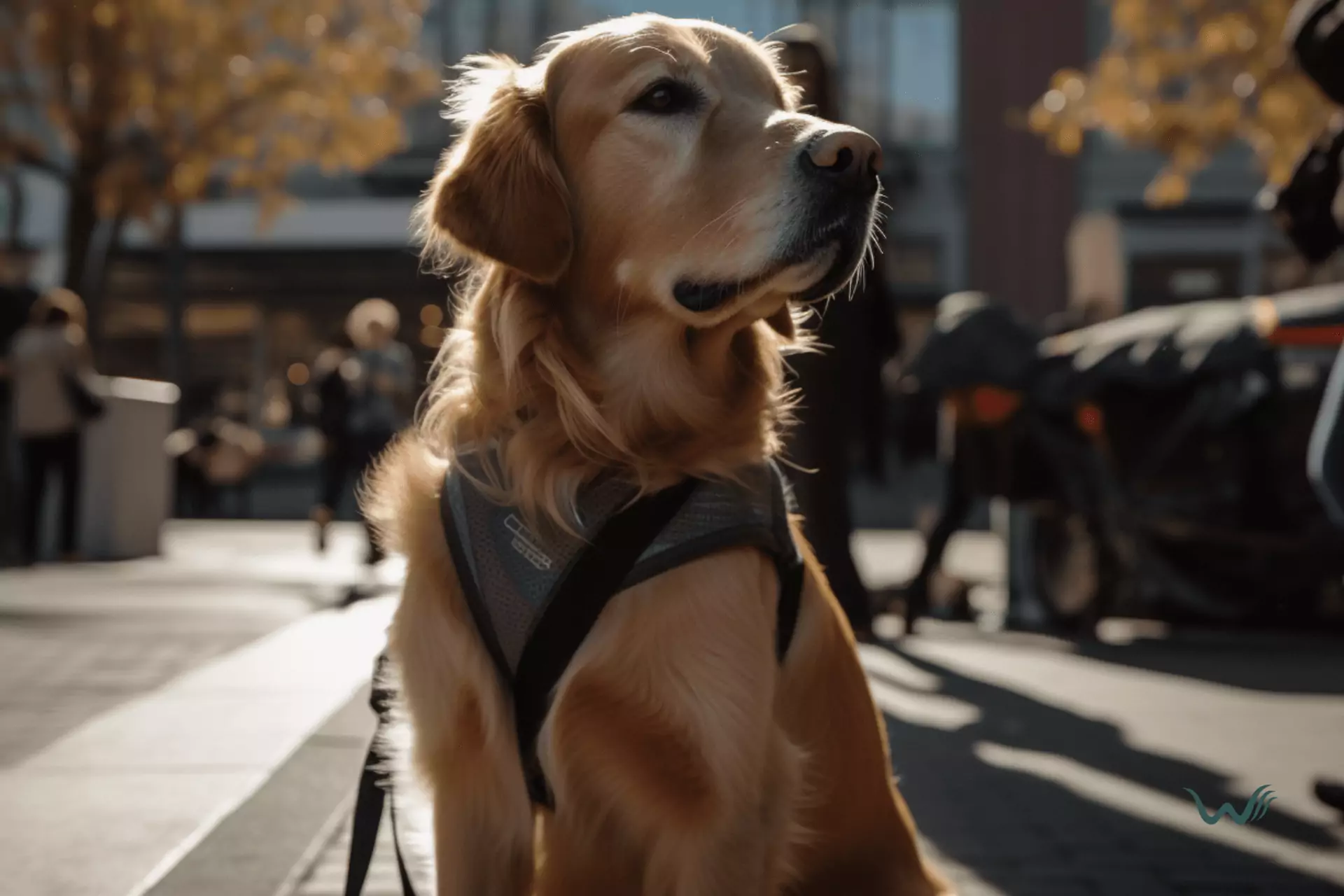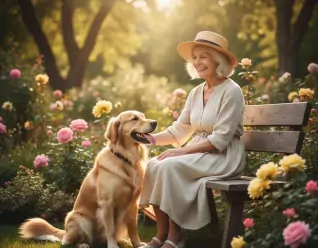

Beyond Tasks: Building Skills & Confidence in Service Dogs
by Haley Mills
Last updated: April 20, 2024
Verified and Approved by:
Angela Morris,
MSW, LCSW
Fact Checked

Hey there, dog lovers! Are you ready to dive into the world of positive reinforcement training for service dogs? Well, buckle up because we’re about to embark on a pawsome journey that will enhance their skills and make you giggle along the way.
Now, we all know that service dogs are brilliant and capable of performing some truly amazing tasks. But how do they learn to do all those things? That’s where positive reinforcement training comes in.
By using treats, praise, and a whole lot of belly rubs, you can teach these furry heroes to become even more super-duper awesome. So, get ready to discover the secrets of establishing a strong foundation, teaching specific skills and tasks, and even generalizing their training in various environments. Trust me, it’s going to be a tail-wagging good time!
Key Takeaways
- Positive reinforcement training is effective for enhancing the skills of service dogs.
- Creating a positive and supportive environment is crucial for successful training.
- Consistency and commitment are necessary for continuous learning and improvement.
- Generalizing training in various environments helps service dogs become adaptable.
Understanding Positive Reinforcement Training
Positive reinforcement training, which focuses on rewarding desired behaviors rather than punishing unwanted ones, has been found to be highly effective in enhancing the skills of service dogs. In fact, a study conducted by the University of Pennsylvania found that dogs trained using positive reinforcement methods were more successful in learning new tasks and had higher obedience levels compared to dogs trained using punishment-based methods.
So, if you’re thinking of training a service dog, positive reinforcement is the way to go!
Now, I know what you’re thinking. How exactly does positive reinforcement training work? Well, let me break it down for you in the simplest way possible.
Imagine you’re trying to teach your service dog to sit. Instead of scolding them or using force when they don’t sit, you would reward them with a treat or praise when they do sit. This positive reinforcement creates a positive association in their minds, making them more likely to repeat the desired behavior.
Establishing a Strong Foundation
To establish a strong foundation for your service dog’s training, you should start by creating a structured and consistent environment. This means setting clear boundaries and expectations for your dog and sticking to them. Dogs thrive on routine, so it’s important to establish a daily schedule that includes regular feeding times, exercise, and training sessions. Consistency is key when it comes to training, so make sure to use the same commands and cues each time and reinforce them with positive rewards. This will help your dog understand what is expected of them and make the training process more effective.
Now, let’s dive into a nested bullet point list to keep you engaged and interested:
- First, establish a designated training area where you and your dog can focus without distractions. This could be a specific room in your house or a quiet corner in your backyard.
- Secondly, create a training plan that breaks down the skills you want to teach your dog into small, manageable steps. Remember, Rome wasn’t built in a day, and neither is a well-trained service dog!
- Lastly, make sure to incorporate play and fun into your training sessions. Dogs are more likely to learn and retain information when they are enjoying themselves. So, don’t be afraid to let loose, get silly, and have a good time with your furry friend during training!
Teaching Specific Skills and Tasks
By using a carrot-and-stick approach, trainers can effectively teach service dogs specific skills and tasks. You know, it’s like that old saying, “You can lead a dog to water, but you can’t make it fetch.” Well, with positive reinforcement training, you can actually make that dog fetch and so much more!
It’s all about finding the right balance between rewards and consequences. So, imagine you’re teaching a service dog to open doors. You start by showing them how to paw at the handle, and when they do it correctly, you reward them with a tasty treat. But if they don’t get it right, you don’t punish them or scold them. Instead, you just withhold the reward, and they quickly learn that they need to try again. It’s like a game of trial and error, but with plenty of treats along the way!
Now, let’s say you want to teach a service dog to turn on the lights. You might start by showing them how to nudge the light switch with their nose, and when they do it correctly, you give them a big, enthusiastic “Good job!” and maybe even a belly rub. But if they get a little too enthusiastic and accidentally knock over a lamp, you don’t get mad. You just calmly redirect them and try again.
It’s all about creating a positive and supportive environment where the dog feels encouraged to learn and try new things. And hey, if they happen to learn a few extra tricks along the way, like rolling over or playing dead, well, that’s just a bonus! Positive reinforcement training makes the possibilities endless, and the laughs are guaranteed.
Generalizing Training in Various Environments
Generalizing training in different environments helps your service dog become more adaptable and versatile in their tasks. By exposing them to a variety of settings, you are preparing them to handle any situation they may encounter while on duty. This is important because service dogs need to be able to perform their tasks reliably, regardless of the environment they are in.
To illustrate the importance of generalizing training, let’s use a table to compare a trained service dog and an untrained dog in different environments:
| Environment | Trained Service Dog | Untrained Dog |
|---|---|---|
| Busy city street | Remains focused on handler, ignores distractions | Easily gets overwhelmed, pulls on the leash |
| Noisy restaurant | Sits quietly under the table | Barks and begs for food |
| Public transportation | Calmly rides the bus or subway | Gets anxious and paces around |
| Crowded shopping mall | Walks politely on a loose leash | Gets excited and jumps on people |
How Does Positive Reinforcement Training Differ for Service Dogs and Therapy Dogs?
Positive reinforcement therapy dog training for service dogs focuses on building specific task-oriented behaviors, while for therapy dogs, it emphasizes calm and gentle demeanor to provide comfort. Both types require consistent rewards for desired behaviors, but the training techniques and ultimate goals differ to suit their respective roles.
Continuous Learning and Improvement
Don’t forget to learn and improve when training your service dog continuously. Just like humans, dogs are always capable of learning new things and improving their skills. So, keep those treats and toys handy and get ready for some fun training sessions!
Remember, training your service dog is not a one-time event. It’s an ongoing process that requires consistency and commitment. Take the time to assess your dog’s progress and identify areas where they can improve. Maybe your dog needs a little more practice with a certain command or maybe they need to work on their focus in distracting environments. Whatever it may be, don’t be afraid to adapt your training techniques and try new approaches.
But hey, training doesn’t have to be all serious and strict. Inject some fun and humor into the process! Get creative with your training sessions and turn them into games. Use silly voices, make funny faces, and celebrate even the smallest victories with a happy dance.
Frequently Asked Questions
Can positive reinforcement training be used for other types of animals, such as cats or birds?
Absolutely! Positive reinforcement training can be used for all types of animals, including cats and birds. By using treats, praise, and play, you can teach them new tricks and behaviors while keeping it fun and engaging.
How long does it typically take to establish a strong foundation in positive reinforcement training for service dogs?
Establishing a strong foundation in positive reinforcement training for service dogs is no walk in the park! It takes time, dedication, and patience. But fear not, with consistent practice and a little doggy magic, you’ll be on your way to canine greatness!
Is it possible to teach a service dog multiple specific skills and tasks, or is it better to focus on one at a time?
It’s definitely possible to teach a service dog multiple skills and tasks, but it’s better to focus on one at a time. You don’t want your pup to have a mental meltdown trying to remember everything. Take it slow and steady, and soon they’ll be a doggie genius!
Are there any specific challenges or considerations when generalizing training in various environments for service dogs?
Are there any challenges or considerations when generalizing training in different environments for service dogs? Yes, there are! It’s like a suspenseful adventure, with unpredictable distractions and new situations. But fear not, we’ll guide you through this exciting journey!
Are there any resources or additional training programs available for service dogs and their handlers to continue their learning and improvement journey beyond the basics covered in this article?
Looking to take your service dog’s training to the next level? There are plenty of resources out there to continue their learning journey! Check out advanced training programs and online resources for ongoing improvement. Keep those tails wagging!
Certify Your Emotional Support Animal Today

Why You Can Rely on Us?
At Wellness Wag, we believe your pet deserves care rooted in both science and compassion. Each article is carefully researched, written in clear language for pet owners, and then reviewed by qualified professionals to ensure the information is evidence-based, current, and practical for real-life care. Our goal is to help you feel confident in making informed decisions about your pet’s health and well-being.
Reviewed by
Angela Morris, MSW, LCSW
Angela is a licensed clinical social worker with 20 years of experience in patient advocacy and community mental health. She has assisted numerous clients with ESA evaluations and brings a deep understanding of disability accommodations, ensuring that all information is accurate, supportive, and practical.

Written by :
Haley Mills
Last Updated :
April 20, 2024










